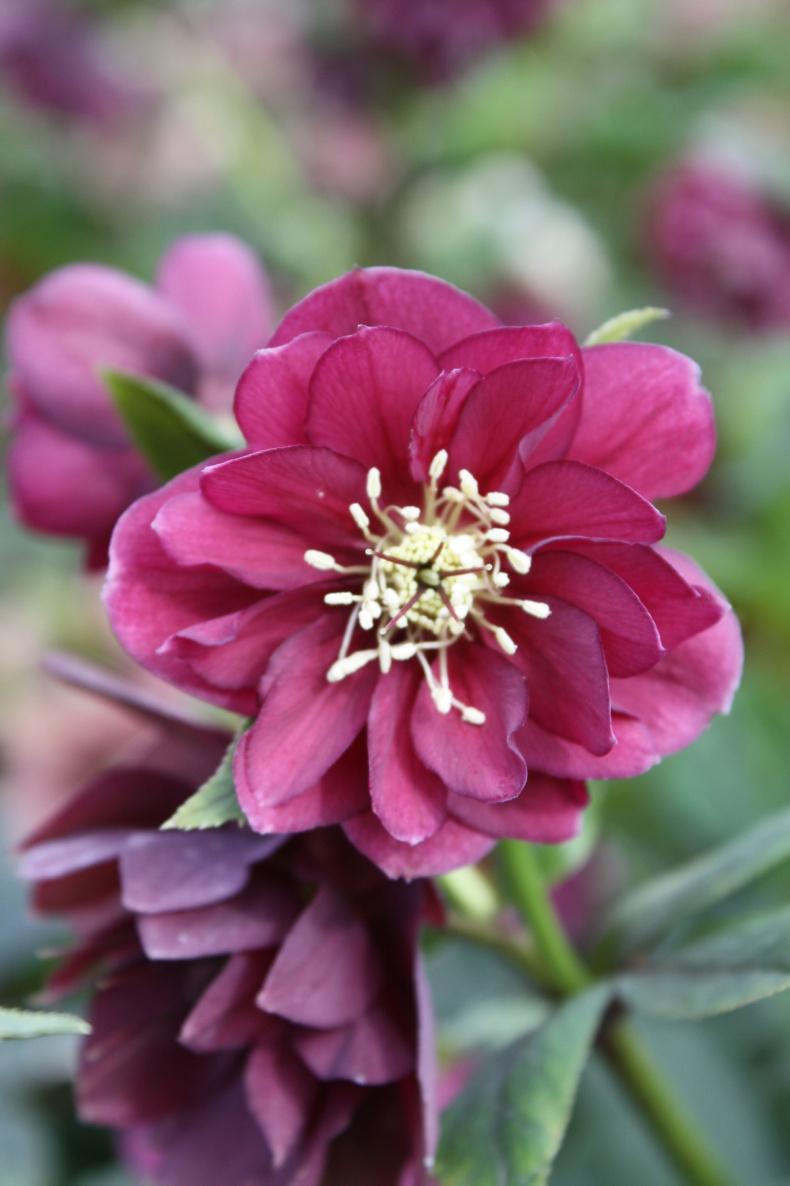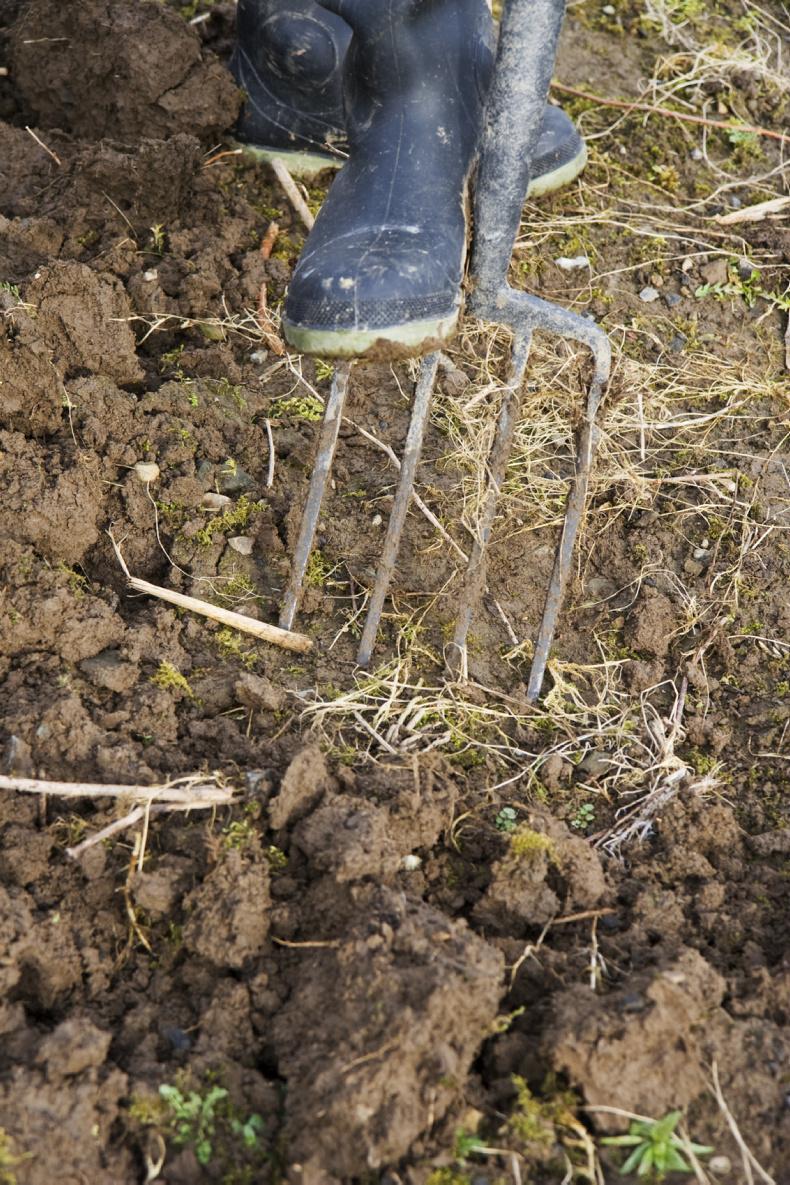Very few gardens feature perennial flowers in beds or borders on their own. They are mostly used in mixed borders of perennial flowers and shrubs.
The shrubs form the permanent structure of the planting and the perennial flowers fill in between and underneath the shrubs.
The presence of shrubs among the flowers can dramatically change the fortunes of perennials, because the shrubs grow steadily outwards and tend to over-shadow and shade out perennial flowers that are not shade-lovers.

Double-flowered hellebore.
It is a good idea not to allow a bed or border to become tired and worn out, but to make small changes each year.
Non-woody perennial flowers, such as lupins, campanula, phlox, red hot poker, hosta, bergenia and monarda, are quick-growing and fill out spaces in a few short years.
Having filled the available space, some kinds remain as they are, others invade neighbouring plants and some tend to die out in the middle or perhaps die altogether. Some kinds have ‘running roots’.
These can be actual roots or underground stems that spread out from the plant and then produce buds that strike for the surface.
Examples are Euphorbia griffithii, Japanese anemone, some geraniums, alstroemeria and Libertia peregrinans.
Plants with this structure can be a real nuisance and tend to take over other plants’ space.
On the other hand, they can be very useful in a semi-wild setting where their invasive nature will allow them to colonise ground in the face of stiff competition, even from weeds.
If they can be allowed to grow unchecked there is no difficulty about growing them, but if they are to be used in a border with less-vigorous plants, they will create a lot of bother trying to contain them.
This will require lifting excess portions every couple of years and perhaps even each year.
Many kinds have stems that spread on the soil surface or just below, rooting as they go and spreading outwards, such as persicaria, geraniums, bergenia and monarda
This would create a lot of effort and if this cannot be provided, these running roots kinds are best avoided.
Many kinds have stems that spread on the soil surface or just below, rooting as they go and spreading outwards, such as persicaria, geraniums, bergenia and monarda.
These are slow spreaders, not as invasive as the running root kinds but can gradually make a broad clump.
In some of these, the clumps develop a gap in the centre with poor growth or no growth and vigour around the edges.
These then must be lifted every few years, the useless middle discarded and the outside vigorous bits replanted.
Other perennials create a neat cluster of shoots from a common rootstock, for instance hellebores, epimedium, peony, some euphorbias, some geraniums, some campanulas and crambe. Others form a tight grouping of stems and buds at soil level, fed by a mass of fibrous roots, such as agapanthus, dierama, phormium, astelia, sedum, red hot poker and hosta.
Both of these groups are relatively well-behaved and rarely need lifting, dividing and re-planting.
In some cases any disturbance is not well tolerated, such as peony and dierama.
It is easy to tell each of these main groups apart, even without knowing the name of the plant or doing any research.
A close look at the root structure will reveal what it is likely to do.
Plants with extending stems, or roots with shoots at a distance from the main clump are ‘runners’ and, in pots often ring the pot around.
Slow spreaders have shorter stems and other fill a pot with shoots. The tighter kinds hold their buds in a tight grouping and often have just a single thick rootstock in a pot as a young plant.
This is a good time to re-arrange a border as the flowers will recover quickly as new growth begins.
Look closely at a border and decide which spots to change. This might mean lifting, dividing and replanting; it might mean outright removal and replacement; or it might mean moving an existing plant to a more suitable spot for space, decorative value or the conditions necessary for good flowering.

Vegetable garden
Ground conditions changed dramatically in recent weeks following a period in December and January of little or no rain and unseasonably high temperature levels.
There is plenty of time yet and much depends on the nature of the soil.
Heavy ground tends to hold water and it may be weeks before it can be dug over
Light, sandy soil can be dug over a few hours after rain but it can also be vulnerable to nutrients leaching, so a no-dig system might suit better, with a light layer of garden compost of rotted manure applied.
Heavy ground tends to hold water and it may be weeks before it can be dug over. But take the opportunity if it arises.
When conditions are not great outdoors, vegetable seeds can be sown under any greenhouse cover.
Sprout them indoors with a little heat and move them out.
Try lettuce, early cabbage, cauliflower, peas, broad beans, onions, celery, per pack instructions. Carrots are sown in a cold frame or tunnel.
Trees, shrubs and roses
The ground is too wet for planting – there is a danger of leaving the roots in waterlogged soil. Roses can be pruned at any time.
Check that all tree ties are in position, and trees and shrubs planted last year are not showing signs of wind-rocking.
Flowers
There has been a lot of rain in recent days and the ground is sticky, but if it dries out a bit border flowers can be lifted and divided, if they need it.
Many of these are beginning to sprout. Bedding flowers can be started off in a heated propagator now.
Fruit and vegetables
Finish pruning apple and pear trees. Seed potatoes of early varieties can be put in to sprout now. Check on fruit trees to see if they have been rocked by strong wind.
Lift rhubarb stools for forcing in a dark, warm place. Plant garlic if the soil is dry enough.
Lawn
Lawn moss can be controlled with iron sulphate. If the soil is firm enough, a first mowing can be carried out at the nearest opportunity.
If the lawn area is drained, see if the drainage outlets are clear to facilitate the removal of surplus water. Get the mower serviced.
Greenhouse and house plants
If they are given reasonable care, Christmas houseplants, such as poinsettia, azalea and cyclamen can be made to last longer.
They will need watering but only just enough to keep them moist, certainly do not leave them standing in water. Give no feeding yet.
Very few gardens feature perennial flowers in beds or borders on their own. They are mostly used in mixed borders of perennial flowers and shrubs.
The shrubs form the permanent structure of the planting and the perennial flowers fill in between and underneath the shrubs.
The presence of shrubs among the flowers can dramatically change the fortunes of perennials, because the shrubs grow steadily outwards and tend to over-shadow and shade out perennial flowers that are not shade-lovers.

Double-flowered hellebore.
It is a good idea not to allow a bed or border to become tired and worn out, but to make small changes each year.
Non-woody perennial flowers, such as lupins, campanula, phlox, red hot poker, hosta, bergenia and monarda, are quick-growing and fill out spaces in a few short years.
Having filled the available space, some kinds remain as they are, others invade neighbouring plants and some tend to die out in the middle or perhaps die altogether. Some kinds have ‘running roots’.
These can be actual roots or underground stems that spread out from the plant and then produce buds that strike for the surface.
Examples are Euphorbia griffithii, Japanese anemone, some geraniums, alstroemeria and Libertia peregrinans.
Plants with this structure can be a real nuisance and tend to take over other plants’ space.
On the other hand, they can be very useful in a semi-wild setting where their invasive nature will allow them to colonise ground in the face of stiff competition, even from weeds.
If they can be allowed to grow unchecked there is no difficulty about growing them, but if they are to be used in a border with less-vigorous plants, they will create a lot of bother trying to contain them.
This will require lifting excess portions every couple of years and perhaps even each year.
Many kinds have stems that spread on the soil surface or just below, rooting as they go and spreading outwards, such as persicaria, geraniums, bergenia and monarda
This would create a lot of effort and if this cannot be provided, these running roots kinds are best avoided.
Many kinds have stems that spread on the soil surface or just below, rooting as they go and spreading outwards, such as persicaria, geraniums, bergenia and monarda.
These are slow spreaders, not as invasive as the running root kinds but can gradually make a broad clump.
In some of these, the clumps develop a gap in the centre with poor growth or no growth and vigour around the edges.
These then must be lifted every few years, the useless middle discarded and the outside vigorous bits replanted.
Other perennials create a neat cluster of shoots from a common rootstock, for instance hellebores, epimedium, peony, some euphorbias, some geraniums, some campanulas and crambe. Others form a tight grouping of stems and buds at soil level, fed by a mass of fibrous roots, such as agapanthus, dierama, phormium, astelia, sedum, red hot poker and hosta.
Both of these groups are relatively well-behaved and rarely need lifting, dividing and re-planting.
In some cases any disturbance is not well tolerated, such as peony and dierama.
It is easy to tell each of these main groups apart, even without knowing the name of the plant or doing any research.
A close look at the root structure will reveal what it is likely to do.
Plants with extending stems, or roots with shoots at a distance from the main clump are ‘runners’ and, in pots often ring the pot around.
Slow spreaders have shorter stems and other fill a pot with shoots. The tighter kinds hold their buds in a tight grouping and often have just a single thick rootstock in a pot as a young plant.
This is a good time to re-arrange a border as the flowers will recover quickly as new growth begins.
Look closely at a border and decide which spots to change. This might mean lifting, dividing and replanting; it might mean outright removal and replacement; or it might mean moving an existing plant to a more suitable spot for space, decorative value or the conditions necessary for good flowering.

Vegetable garden
Ground conditions changed dramatically in recent weeks following a period in December and January of little or no rain and unseasonably high temperature levels.
There is plenty of time yet and much depends on the nature of the soil.
Heavy ground tends to hold water and it may be weeks before it can be dug over
Light, sandy soil can be dug over a few hours after rain but it can also be vulnerable to nutrients leaching, so a no-dig system might suit better, with a light layer of garden compost of rotted manure applied.
Heavy ground tends to hold water and it may be weeks before it can be dug over. But take the opportunity if it arises.
When conditions are not great outdoors, vegetable seeds can be sown under any greenhouse cover.
Sprout them indoors with a little heat and move them out.
Try lettuce, early cabbage, cauliflower, peas, broad beans, onions, celery, per pack instructions. Carrots are sown in a cold frame or tunnel.
Trees, shrubs and roses
The ground is too wet for planting – there is a danger of leaving the roots in waterlogged soil. Roses can be pruned at any time.
Check that all tree ties are in position, and trees and shrubs planted last year are not showing signs of wind-rocking.
Flowers
There has been a lot of rain in recent days and the ground is sticky, but if it dries out a bit border flowers can be lifted and divided, if they need it.
Many of these are beginning to sprout. Bedding flowers can be started off in a heated propagator now.
Fruit and vegetables
Finish pruning apple and pear trees. Seed potatoes of early varieties can be put in to sprout now. Check on fruit trees to see if they have been rocked by strong wind.
Lift rhubarb stools for forcing in a dark, warm place. Plant garlic if the soil is dry enough.
Lawn
Lawn moss can be controlled with iron sulphate. If the soil is firm enough, a first mowing can be carried out at the nearest opportunity.
If the lawn area is drained, see if the drainage outlets are clear to facilitate the removal of surplus water. Get the mower serviced.
Greenhouse and house plants
If they are given reasonable care, Christmas houseplants, such as poinsettia, azalea and cyclamen can be made to last longer.
They will need watering but only just enough to keep them moist, certainly do not leave them standing in water. Give no feeding yet.








 This is a subscriber-only article
This is a subscriber-only article










SHARING OPTIONS: